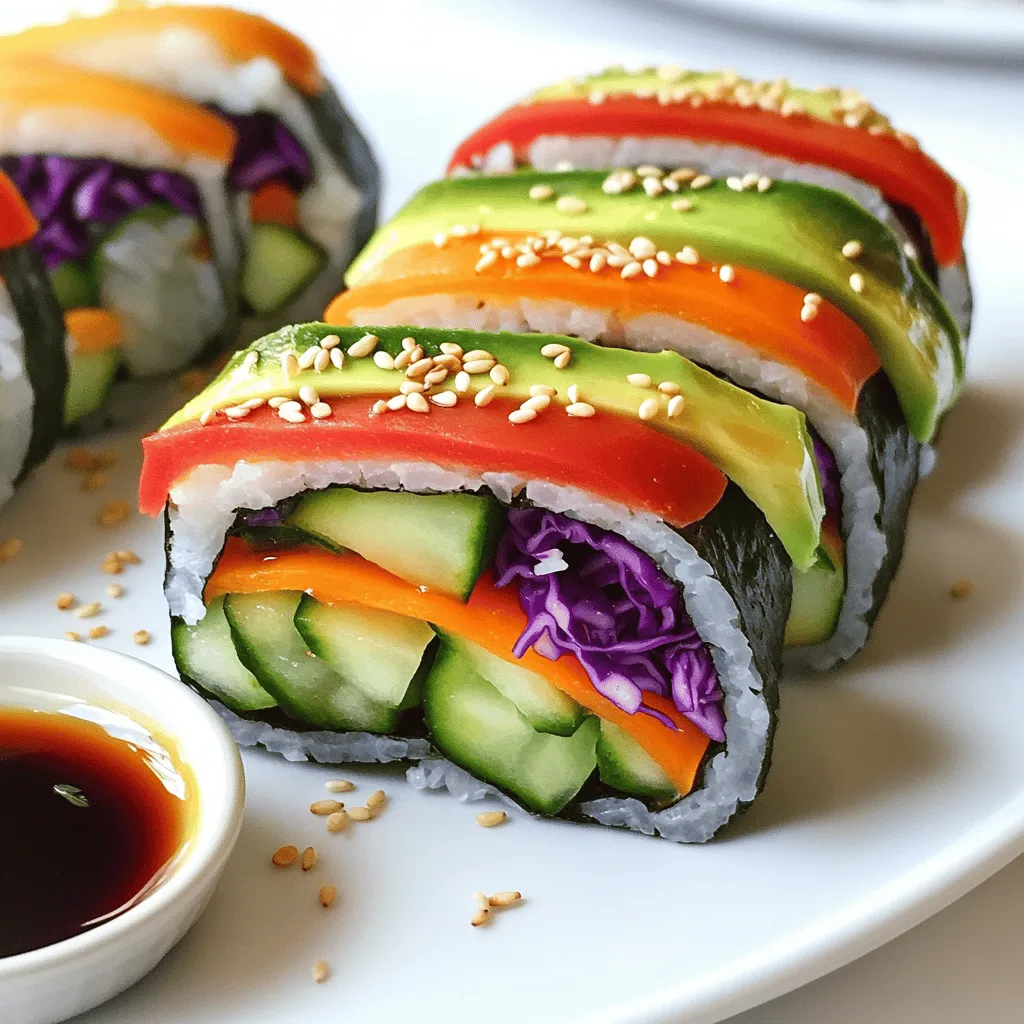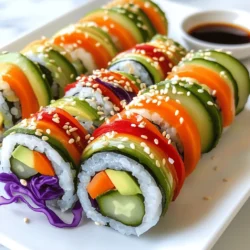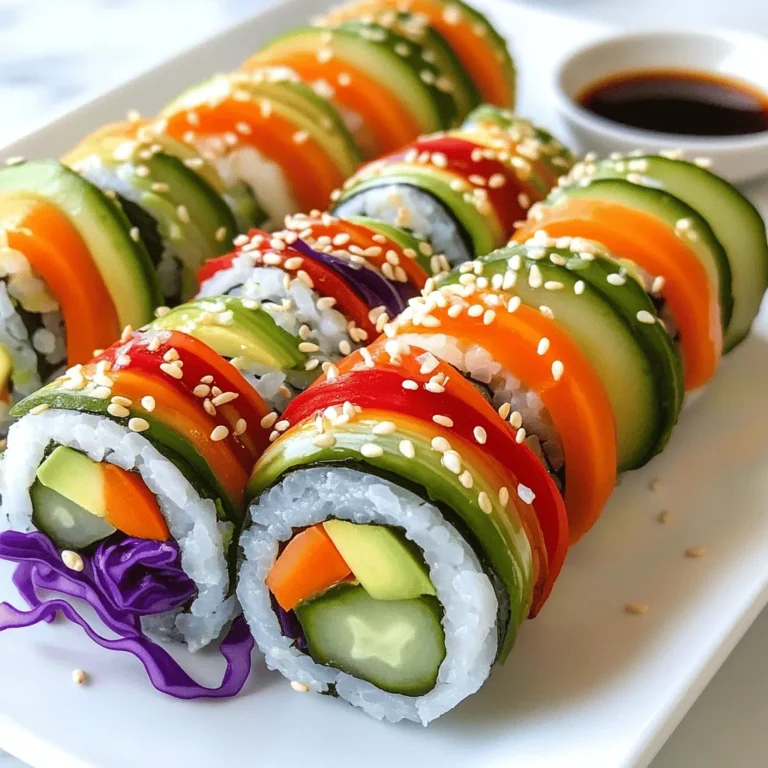Looking to add some color to your meals? Rainbow Veggie Sushi Rolls are the perfect dish! Packed with vibrant veggies, these sushi rolls are both fun to make and good for you. They’re great for lunch, dinner, or a snack. In this post, I’ll guide you through easy steps, key tips, and tasty variations. Ready to roll? Let’s dive in and create your colorful and healthy delight!
Ingredients
Main Ingredients Overview
The main ingredients for Rainbow Veggie Sushi Rolls are simple and fresh. Here’s what you need:
– 1 cup sushi rice
– 1 1/4 cups water
– 2 tablespoons rice vinegar
– 1 tablespoon sugar
– 1 teaspoon salt
– 4 sheets nori (seaweed)
– 1 small cucumber, julienned
– 1 medium carrot, julienned
– 1 bell pepper (red or yellow), thinly sliced
– 1 ripe avocado, sliced
– 1/2 cup purple cabbage, shredded
– Soy sauce, for dipping
– Sesame seeds, for garnish (optional)
– Pickled ginger and wasabi (optional, for serving)
Each ingredient adds its own flavor and color. The sushi rice creates a soft base. The nori wraps everything together. Fresh veggies add crunch and bright colors.
Recommended Tools
To make these sushi rolls, you need a few tools:
– Bamboo sushi mat for rolling
– Sharp knife for cutting
– Fine mesh strainer for rinsing rice
– Medium saucepan for cooking rice
– Small bowl for mixing vinegar, sugar, and salt
Using these tools helps you create perfect rolls. The sushi mat is key for rolling tightly.
Nutritional Highlights
Rainbow Veggie Sushi Rolls are not just pretty; they are healthy too. Here are some highlights:
– Sushi rice provides carbs for energy.
– Fresh vegetables are full of vitamins and fiber.
– Avocado offers healthy fats.
– Low-calorie soy sauce adds flavor without excess calories.
These rolls are a great way to eat more veggies. They are colorful, fun, and packed with nutrients. Enjoy this vibrant meal with friends or family.
Step-by-Step Instructions
Preparing the Sushi Rice
To start, rinse the sushi rice. Use a fine mesh strainer and cold water. This step removes extra starch. Rinse until the water runs clear. Next, cook the rice in a medium pot. Combine the rinsed rice with 1 1/4 cups water. Bring it to a boil, then lower the heat. Cover and let it simmer for 15 minutes. After 15 minutes, take it off the heat. Let it sit, covered, for another 10 minutes. This helps the rice become tender.
Now, we season the rice. In a small bowl, mix rice vinegar, sugar, and salt. Fold this mixture into the cooked rice gently. Use a wooden spoon for this task. Allow the rice to cool to room temperature. This cooling makes it easier to roll later.
Cutting and Preparing the Vegetables
While the rice cools, it’s time to prepare the veggies. Start with the cucumber. Cut it into thin, matchstick-sized pieces. Next, julienne the carrot in the same way. Then, slice the bell pepper into thin strips. For the avocado, cut it into slices. Lastly, shred the purple cabbage. Aim for pieces that are easy to roll. This colorful mix makes your sushi vibrant and fun.
Rolling and Cutting the Sushi
Now, grab your bamboo sushi mat. Place it on a flat surface. Lay a sheet of nori, shiny side down, on the mat. Wet your hands to prevent sticking. Spread about 1/4 of the sushi rice evenly over the nori. Leave a 1-inch border at the top.
Next, it’s time for the veggies. Arrange your colorful selection of cucumber, carrot, bell pepper, avocado, and cabbage across the middle of the rice. Now, roll it up! Start from the bottom. Lift the bamboo mat and roll tightly. Press gently but don’t squash it. Keep rolling until you reach the top edge without rice.
To seal the roll, moisten the top border of the nori with a bit of water. This helps it stick together. Now, slice the roll into 6-8 pieces. Use a sharp, wet knife for clean cuts. Wipe the knife between cuts for best results. Finally, serve your sushi rolls with soy sauce and garnish with sesame seeds. Enjoy this colorful and healthy delight!
Tips & Tricks
Essential Tips for Perfect Sushi Rolls
To make great sushi rolls, follow these tips:
– Use fresh ingredients: Fresh veggies and ripe avocado make a big difference.
– Wet your hands: Keep your hands damp when handling the rice to prevent sticking.
– Don’t overfill: Use just enough filling to avoid messy rolls. A little goes a long way.
– Practice rolling: The more you roll, the better you get. Don’t worry if it’s not perfect!
Common Mistakes to Avoid
Here are some common sushi mistakes:
– Using dry rice: Rinse the rice well to remove starch. This keeps it from being gummy.
– Rolling too tight: If you roll too tightly, the filling might squish out.
– Not sealing the roll: Moisten the edge of the nori to seal it properly.
– Cutting with a dry knife: Always wet your knife for clean cuts.
Best Practices for Presentation
Make your sushi look as good as it tastes:
– Use a sharp knife: This helps with clean slices.
– Garnish wisely: Sprinkle sesame seeds or lay down colorful veggies on the plate.
– Arrange artfully: Place the rolls neatly on a plate. A little care in presentation goes a long way!
– Serve with style: Offer soy sauce, pickled ginger, and wasabi in small bowls for a nice touch.
By following these tips, you can create beautiful and tasty rainbow veggie sushi rolls that impress everyone.

Variations
Gluten-Free Options
You can easily make gluten-free rainbow veggie sushi. Just use gluten-free soy sauce instead of regular soy sauce. Ensure the nori sheets are also gluten-free. Most nori is gluten-free, but it’s best to check the label. You can also replace the rice vinegar with apple cider vinegar. This keeps the flavor bright and tangy.
Vegan and Vegetarian Adjustments
This recipe is already vegan-friendly. Use plant-based ingredients and skip fish. You can add tofu or tempeh for extra protein. Marinate the tofu in soy sauce or sesame oil for added flavor. Try adding other vegetables like spinach or radish for more color and taste.
Kid-Friendly Modifications
Kids love colorful food! Let them pick their favorite veggies. You can use fun shapes with cookie cutters. Roll the sushi tighter for smaller bites. Try using a sweeter dipping sauce, like teriyaki, to make it more appealing. You can also serve with fruit on the side for a complete meal.
Feel free to explore these variations to suit your tastes.
Storage Info
How to Store Leftover Sushi Rolls
To keep your leftover sushi rolls fresh, wrap them tightly in plastic wrap. This helps prevent air from drying them out. Place the wrapped rolls in an airtight container. Store them in the fridge. They are best enjoyed within 24 hours for the best taste and texture.
Freezing and Reheating Tips
If you want to store sushi rolls longer, freezing is an option. However, note that texture may change upon thawing. Wrap each roll tightly in plastic wrap. Place the wrapped rolls in a freezer-safe bag or container. When you’re ready to eat, thaw them in the fridge overnight. Avoid reheating sushi; it tastes best cold.
Best Practices for Freshness
Always use fresh ingredients for your sushi. The rice should be fluffy and slightly sticky. Keep the rolls away from strong odors in the fridge. To maintain color and flavor, consume them soon after making. If you have extra veggies, store them in water to keep them crisp.
FAQs
What is the best type of rice for sushi?
The best rice for sushi is sushi rice, also called short-grain rice. This rice has a higher starch content, which helps it stick together. The texture is perfect for rolling and holding ingredients. Always rinse it well before cooking. This step removes extra starch and makes the rice less sticky.
How do you make sushi rice less sticky?
To make sushi rice less sticky, rinse it under cold water until the water runs clear. This removes excess starch. Use the right water-to-rice ratio. For sushi rice, 1 cup of rice to 1.25 cups of water works best. Let it steam after cooking for 10 minutes. This allows the rice to firm up.
Can I use different vegetables for rainbow sushi rolls?
Yes, you can use different vegetables! Feel free to add or swap veggies based on your taste. Try radishes, zucchini, or even sweet potatoes. The key is to cut them thinly for easy rolling. This way, you can create your own colorful combinations.
How long can sushi rolls sit before they go bad?
Sushi rolls are best eaten fresh. They can sit for about 2 hours at room temperature. After that, the rice can dry out or the veggies can become limp. If you need to store them, wrap them tightly in plastic wrap. Keep them in the fridge, where they can last up to 24 hours. For the best taste, eat sushi rolls as soon as possible.
You learned about the key ingredients and tools needed for sushi. We explored how to prepare sushi rice and cut vegetables. I shared tips for making perfect rolls and avoiding common mistakes. You also discovered variations for dietary needs and how to store leftovers.
Sushi making is fun and rewarding. Now, you can impress friends and family with your skills. Enjoy every bite of your sushi creations!


